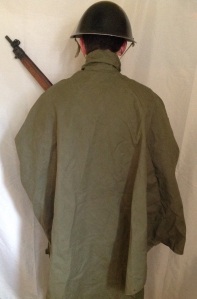When the 1944 pattern Jungle Webbing and associated equipment was introduced the pre-existing rubberised poncho was retained; changing colour from tan to dark green. The poncho had been introduced in World War One as the Sheets, Ground, MkVII, the illustration below was published at the time of its introduction: My example is from nearly half a century later, but in form is virtually identical:
My example is from nearly half a century later, but in form is virtually identical: The fabric is a heavy cotton canvas, prepared with a rubberised finish to make it waterproof (with resultant rubbery smell). The cape has a row of plastic buttons down one edge:
The fabric is a heavy cotton canvas, prepared with a rubberised finish to make it waterproof (with resultant rubbery smell). The cape has a row of plastic buttons down one edge: These are reinforced on the rear to prevent the material being torn:
These are reinforced on the rear to prevent the material being torn: Note the holes along the edge, these allow two ponchos to be tied together to make a crude shelter. At the ‘neck’ is a cotton tape to allow the poncho to be hung up to dry:
Note the holes along the edge, these allow two ponchos to be tied together to make a crude shelter. At the ‘neck’ is a cotton tape to allow the poncho to be hung up to dry: The collar has a button and strip of fabric for fastening:
The collar has a button and strip of fabric for fastening: These allow the collar to be drawn high enough to protect the back of the neck from rain:
These allow the collar to be drawn high enough to protect the back of the neck from rain: This cape has a manufacturer’s mark indicating it was made in 1954 by Strauss and Sons:
This cape has a manufacturer’s mark indicating it was made in 1954 by Strauss and Sons: The 1944 pattern haversack, introduced alongside the green poncho, had a pair of straps at its base that allowed a rolled poncho to be carried safely and still be easily accessible to put on in case of a sudden monsoon rain storm. These capes were practical, but heavy and hot. They were dropped by the British Army in the 60s and 70s in favour of nylon ponchos, but remained in use as ground sheets for shooting ranges and the like where soldiers needed to lie on wet ground. I bought a couple of these six or seven years ago when dealers couldn’t seem to give them away (mine cost £5 each). Since then they seem to have shot up in price and are now fetching £25 or more each.
The 1944 pattern haversack, introduced alongside the green poncho, had a pair of straps at its base that allowed a rolled poncho to be carried safely and still be easily accessible to put on in case of a sudden monsoon rain storm. These capes were practical, but heavy and hot. They were dropped by the British Army in the 60s and 70s in favour of nylon ponchos, but remained in use as ground sheets for shooting ranges and the like where soldiers needed to lie on wet ground. I bought a couple of these six or seven years ago when dealers couldn’t seem to give them away (mine cost £5 each). Since then they seem to have shot up in price and are now fetching £25 or more each.
- Comment
- Reblog
-
Subscribe
Subscribed
Already have a WordPress.com account? Log in now.
[…] Rubberised Poncho […]
Hi,
Great site,
Has a photograph of the marking AF0028 or A6/AF/0028 ever surfaced?
Regards,
Rob